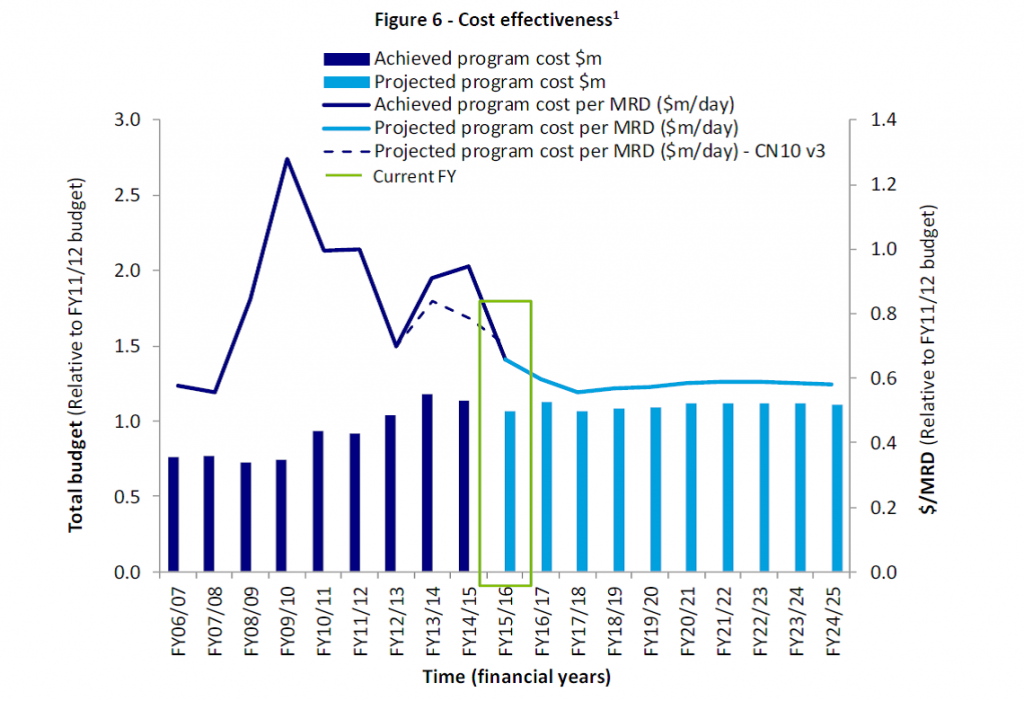Graphs of the week: finally getting the Collins class we paid for
Posted By Andrew Davies on October 27, 2016 @ 11:00
Mark Thomson and I have been following the status of the Collins class submarines for some years now, and we’re happy to see the upbeat new installment of the Coles review [1] (PDF). There’s some good news in the report—which is possibly why it didn’t make much of a ripple in the press when it was released by the Defence and Finance ministers [2] last week.
Let’s start with the availability data. Defence stopped reporting submarine availability some years ago on national security grounds (coincidentally around the same time as the Collins availability hit its nadir [3]), but there’s enough information in the public domain to create a fairly reliable time series. The new report allows me to update the chart we presented [4] on The Strategist in May last year with a new data point for the predicted 2015–16 performance.

The new report was actually completed back in March, so the figure for 2015–16 was a projection made on the basis of performance over the first nine months of the financial year. As far as we can tell, things seem to have run smoothly since then, so the estimate’s probably pretty accurate. The result of 963 unit ready days* is still short of the international benchmark, but it’s 17% better than the Navy’s target when the detailed plan was first pulled together back in 2012. All else being equal, the fleet’s on track to hit the benchmark in the 2016–17 financial year.
That’s an excellent result, and better than even John Coles thought possible:
‘There are few, including myself, who would have confidently predicted in 2012 that the performance now delivered by the Collins Class would graduate from mediocre to excellent in less than four years at almost level funding. … A program once that was considered a “Project of Concern” should perhaps now be treated as an “Exemplar Project”, if such a category existed’.
Coles’ comment about funding is important. One way to achieve increased availability would’ve been to inefficiently throw money at the problem, but that hasn’t been the case. Funding was increased by around 40% in the period after 2011 compared to the preceding years, but the previous Collins funding was inadequate.
When we took a detailed look at ADF support costs for a 2008 paper, we compared the support costs for the Collins fleet with the Anzac frigates. Per vessel, funding for Collins support was just 55% of the surface combatants. Given that the vessels are comparable in tonnage, and that the submarines are certainly no less complex, it’s not hard to understand why the Collins boats spent so much time out of the water in the 2000s. (That’s also an insight into Navy’s priorities back then, and probably explains why the submarine workforce was also poorly managed [5] (PDF) at the time.)
With adequate resources available, it’s now possible to manage the Collins fleet appropriately. While the overall effort costs more in total than in earlier years, the cost to the taxpayer of each operational day—which is what we’re paying for when all’s said and done—is falling. The figure below (reproduced from the new Coles report) shows that the cost effectiveness of the Collins support effort has increased markedly. Each unit ready day now costs 60% of the 2011 price, and less than half of the 2009 price.

There’s no magic at work here. We’re seeing the result of the disciplined and systematic approach that tasks like submarine support require, as well as the deconfliction of a once byzantine network of overlapping responsibilities—which had the net effect of leaving no one responsible for what was a national scandal. The now methodical approach can be seen in the very elegant maintenance schedule [6] for the six boat fleet which was developed by the Coles team.
For now, things are looking good for the nation’s submarine fleet. The Collins fleet is in increasingly good shape, and there’s no reason to think that they won’t be around to see in the new submarines from around 2030. But it’s probably not too early to start thinking about the transition between the fleets. We badly botched the Oberon to Collins transition, and it has taken the best part of 20 years to recover the situation.
One of the challenges that’ll have to be managed is keeping the submarine maintenance capability up to scratch. Depending on the sequencing of deliveries of the new boats, there could be a gap of around 10 years between the last major refit to a Collins boat and the first for the new fleet. Sometime between now and then we’ll need a plan to manage the gap—or we could be back to where we were before Coles and the wider submarine enterprise set about their good work.
*Calculated from Coles’ Figure 3, which quotes 86% of the benchmark, which I assume to be the 1,120 day figure quoted to Parliament last year.
Article printed from The Strategist: https://aspistrategist.ru
URL to article: /graphs-week-finally-getting-collins-class-paid/
URLs in this post:
[1] new installment of the Coles review: http://www.defence.gov.au/casg/Multimedia/Coles%20Beyond%20Benchmark%20Report.pdf
[2] released by the Defence and Finance ministers: http://www.minister.defence.gov.au/2016/10/21/from-concern-to-exemplar-collins-class-submarine-sustainment/
[3] Collins availability hit its nadir: https://aspistrategist.ru/graph-of-the-week-collins-unavailability-2/
[4] we presented: https://aspistrategist.ru/collins-submarine-availability-on-track-but-under-wraps/
[5] submarine workforce was also poorly managed: http://www.defence.gov.au/publications/docs/submarineworkforcesustainability.pdf
[6] very elegant maintenance schedule: https://aspistrategist.ru/planning-for-failure-the-oberon-to-collins-transition/
Click here to print.